Thoughts on our Relationship to Nature
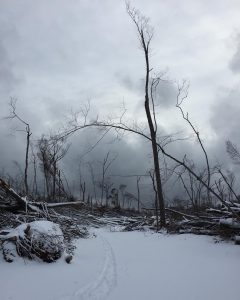
Glen Arbor — Snow is falling softly. Snow is covering the scarred Alligator Hill where the rogue storm in August tore out a five acre strip from the hide of the earth.
Glen Arbor is tiny. I went to sixth grade there. Out behind the school Gerry Barczak and Carl Oleson used to play baseball, honing their catching and throwing skills, determining whether or not the ball was in or out, if a foot was on or off a base, fine-tuning their sense of fairness.
In front of the redbrick school the girls sometimes had bird funerals, trailing around under the pines, trading on the poor bird’s demise to try to understand the meaning of life; ramping up the emotions, and finally, after too many mawkish burials, tamping them down and joining the boys in baseball. If we couldn’t catch, throw, or hit the ball with a bat, then one of them would take our last strike and let us just run the bases.
My family’s home was a mile from the village on a high bluff above Sleeping Bear Bay. We lived in the Day Forest. Alligator Hill, where all the trees came down, was in that forest. The top of this hill was where Susy Schmidt and I liked to gallop our horses on the flat road thickly covered in pine needles, a straight shot to the look-out. The panoramic views of the deep, blue-green lakes were extravagantly gorgeous but we didn’t know this, having nothing with which to compare them.
This past summer when “the big storm” came, I was in the Dennos Museum with American sculptor, Lori Park, visiting from London. She was looking at the aquatic-themed bamboo sculptures by Jinwon Chang, strange and interesting boats, or maybe fish, hanging from the ceiling, inspired by his three near-deaths from drowning.
I was in the wing with the Inuit carvings, thinking about the sense of humor in the face of the polar bear, when I heard a sound like a train in the air. The lights flickered; then went out.
Lori and I found each other again, along with a handful of other Sunday afternoon museum goers, all of us staring out the big plate glass windows at the storm.
“I think we should move away from the windows,” I overheard someone say.
“They won’t break,” someone else responded, but everyone moved back.
“Maybe we need to get out of here,” I said to Lori, under my breath.
“We might be in the safest place,” she said quietly. She was watching the storm.
The air was fluorescent chartreuse, then fluorescent turquoise. Then rain drops the size of cats were falling from a black sky, trees whipping back and forth, with an occasional loud crack, like someone’s leg being broken with a tire iron.
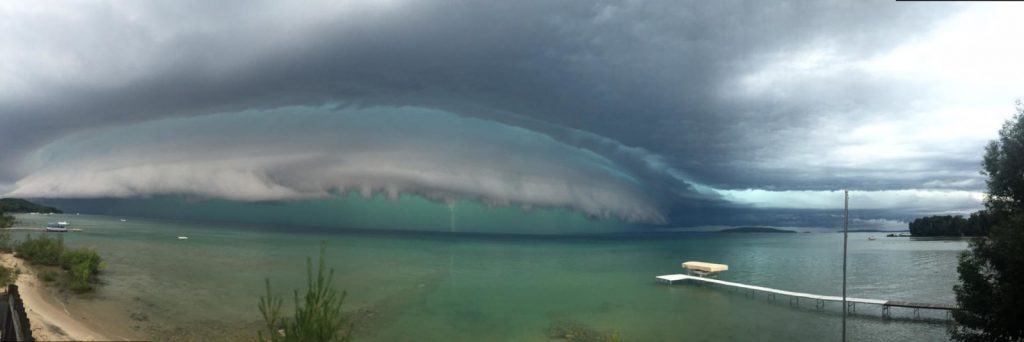
Finally, after what seemed like a long time but was probably not more than 30 minutes, we felt we could make it to the car. We crossed the flooded parking lot, checking for downed electrical wires, sprinting through the still falling rain and the sounds of breaking branches.
Along West Bay there were trees uprooted everywhere and sailboats thrown against the shore. When we drove back to the Leelanau Peninsula on Bugai Road we saw emergency crews. We learned that the storm had winds gusting up to 100 miles an hour. As far as anyone knew, there had been no deaths or even serious injuries.
For weeks one could hear the sound of chain saws. The village of Glen Arbor was closed for several days. This area, voted in 2011 as “the most beautiful place in America” (for that year), seemed to have been particularly brutally struck and emotions were running high. Several people described themselves as having tears in their eyes when they described the way they felt seeing the downed trees. Bobby Sutherland, founder of Cherry Republic and an avid environmental philanthropist, in writing about the storm, described his eyes as being moist.
Trees are ancient and powerful entities in the human imagination. The “men as trees, walking” cited in the Bible, and “fear not, till Birnam Wood do come to Dunsinane” in Shakespeare, show the way images of trees strike deep in the human psyche. I’ve known expert woodcutters, manly and hearty and taciturn, who over time came to refuse to take down any trees but those that were dead or diseased. Do trees have spirits? Maybe, but their majesty is undeniable and the emotions they arouse in us are, too.
An article in the Glen Arbor Sun by Linda Alice Dewey, hiking up Alligator Hill after the storm with a friend, is about hers and her friend’s deep childhood connections to this beloved summer place, how her friend associated the forest with picnics there in “an old ’53 Plymouth” and how as a child her friend had found the water tower “magical” and how it was “a bleak day” when she saw its rusted remains on the ground. They mourned together the loss of the storied childhood fairways of the latter day Gilded Age golf course, abandoned during the Great Depression and, after a brief reprieve in the late 1930s when it functioned for a while as a golf course again, reforested with “little pines” and then no longer the same.
Patty Brandt, staff writer for the Leelanau Enterprise, in an article entitled “Trail of Tears” wrote about people in Glen Arbor who bemoaned the changes the storm brought to the landscape. “I can’t go to that one spot without crying,” a Glen Arbor woman was reported as saying. To see something one thought would last forever, gone, and to feel that loss acutely, is a universal emotional reaction.
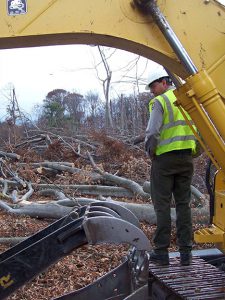
Surely this is how Andrew Blackbird, the last chief of Harbor Springs, felt when he saw the virgin timber cut, the rivers polluted, the grayling and the passenger pigeons on their way to extinction, and his people put on reservations. Blackbird was born in about 1815. “I thought my people were very happy in those days,” he writes, “when they were all by themselves and possessed a wide spread of land, and no one to quarrel with them as to where they should make their gardens, or take timber or make sugar. And fishes of all kinds were so plentiful in the Harbor.”
My tiny grandmother, born in 1868 in White Cloud, walked north with her large husband, a lumberman, on the old Indian trail that ran from Newago to Northport. She said the trunks of the trees looked like yellow plates as far as the eye could see. She saw no Indians, most of whom were presumably dead, or on reservations, or keeping a low profile. Starting in 1838 Andrew Jackson had force-marched the Cherokees and many others, too, west of the Mississippi on the historic Trail of Tears.
Twenty-five miles from Glen Arbor, on a hill behind Tom’s West Bay Shopping Plaza, someone has decided to sculpt a hill, right down to the sand, in order to put in a housing development on what had been a heavily wooded parcel roughly the size of the storm-damaged piece on Alligator Hill. The poor developer will have to wait 50 years for the trees he plants to be as big as the ones he’s removed.
The entire M-72 corridor, starting in Traverse City, as it goes west toward Empire, is utterly changed from the road I knew as a child. Unplanned, random, industrial sprawl crowds the highway. A drive where the sweeping vistas once had the lulling, sweet rhythms of a waltz now has scenery as jarring as death metal.
If you take M-22 from Traverse City, going north out along West Bay, you can see mansions crowding the ridges. The shores of all the lakes, both Lake Michigan and the inland lakes, are cluttered with houses.
There were approximately two billion people on the planet when I was born in 1945, now there are almost nine billion. You don’t need to know a lot of math to see that the way things are going is bad. If we don’t create — and enforce — wise and visionary zoning laws designed to prevent the way untrammeled development will ruin the landscape, then the Leelanau Peninsula will look like Paterson, New Jersey by the end of the century and in four centuries, the amount of time Europeans have been in America, we’re probably going to look, and smell, like Calcutta.
Trees grow, but they don’t grow through concrete.
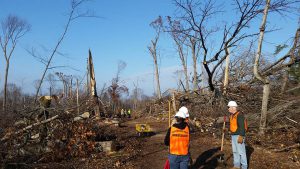
Even the Sleeping Bear Dunes National Lakeshore, where they should have known better and cared more, installed an asphalt bike trail along the base of my mother’s hill, killing the arbutus. It will never grow back.
I like the bike trail, I want to make clear. I think there should be gravel bike trails and hiking paths along all the roads, on both sides, wide enough that a person doesn’t need to be afraid of being hit by a car.
Natural beauty is important. It inspires. It heals. It provides a moral base-line. It’s how we understand the difference between life and death. It’s our most ancient biofeedback system, one to which we are innately attuned and hard-wired to need. It has always been a birthright, but because we have an increasing number of people, it no longer is.
I grew up in a house on a hill and we had a cottage on the lake, too. But that way of life is not going to be sustainable if our great-grandchildren are going to be able to experience nature the way we did.
Residences and stores need to be clustered in cities, towns and villages. Public transportation needs to replace cars. Solar and wind need to replace fossil fuels. We need to stop polluting our air and water. Industry needs to be where no one can see it. Farmland needs to be preserved. Parks and green spaces need to be everywhere and highways need to be landscaped. This is common sense.
It’s normal to care about the tree that comes down in one’s own backyard and normal to not care as much about the tree that comes down in someone else’s. Novelist Karl Ove Knausgaard writing recently in The New Yorker, confessed that he didn’t really think that much about the images on TV of the Syrian migrants crossing Europe until he saw “a dead toddler washed up on the gravel of a Turkish beach” and knew that could be his child.
We need to take the grief we feel about the loss of trees and the scarring of natural beauty in a landscape we know, and extrapolate, expand our empathy, and apply it to the loss of trees and scarring of natural beauty everywhere. If we sentimentalize our relationship to nature, without at the same time taking into account the need to preserve it for everyone and improve everyone’s access, we cheapen our emotions. We risk becoming ridiculous, like grade school girls having way too many bird funerals.
We need to understand that natural beauty is important not just for a few sensitive souls like us, but for all; and, frankly, the least sensitive need it most. A lot of poorly planned development is created by people never given a chance to appreciate natural beauty when they were young.
If we view trees coming down in the wind as a tragedy, a word used by several to describe the summer wind storm, we should nonetheless be careful to steer clear of associating it figuratively or otherwise with something like the Trail of Tears where thousands died.
Changing the way we think about land will not be easy because we associate land ownership with freedom, with democracy. The men who wrote The Declaration of Independence, knowing that change is difficult for people, wrote, “mankind are (sic) more disposed to suffer, while evils are sufferable, than to right themselves by abolishing the forms to which they are accustomed. . .”
Ten thousand years ago people taught themselves to eat little grains of wheat, instead of beef. The grain was less nutritious and probably less tasty, but it was steadily available. It meant people could stay in one place instead of chasing animals. This switch from hunting and gathering to agriculture created civilization as we know it.
As recently as 50 years ago we started to learn about the ill effects of smoking and began to educate ourselves not to do it. In an astonishingly short period of time, we’ve managed to reverse a trend that seemed insensible to change.
Now we need to teach ourselves to not destroy the land. This will feel strange at first because we’re used to thinking that someday we would like a house on a hill or a cottage on the shore. But it’s time. Unless we want our great-grandchildren to live in a world from which natural beauty has been obliterated, we need to change.
We need to navigate the distance between this land and these trees, to that land and those trees. It’s about seeing one’s self as another. Access to natural beauty needs to be declared an inalienable right, not just for the few, but for all.
The views expressed here are those of the writer’s. The Leelanau Conservancy has a long standing practice of not taking sides in issues of development.
. . . .
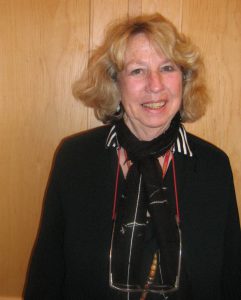 Kathleen Stocking is an award-winning essayist who lives on the Leelanau Peninsula. Her third book, “The Long Arc of the Universe,” is scheduled to be published in the spring of 2016.
Kathleen Stocking is an award-winning essayist who lives on the Leelanau Peninsula. Her third book, “The Long Arc of the Universe,” is scheduled to be published in the spring of 2016.
From a New York Times review: “All of us are watchers, but few are observers. Missing are the village elders and seers, the astute perceivers who interpreted life and effort through nature and the primal cycles. Kathleen Stocking is one of those seers, and she’s delightful.”



